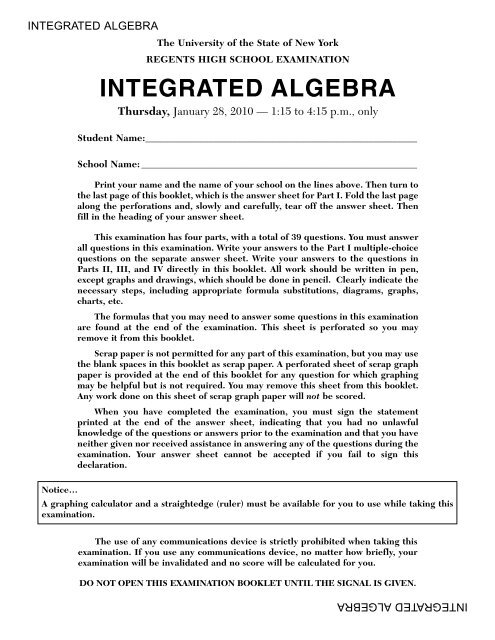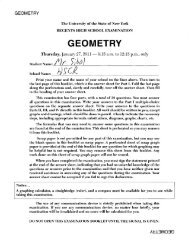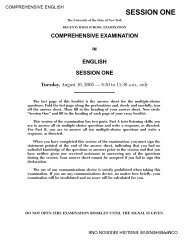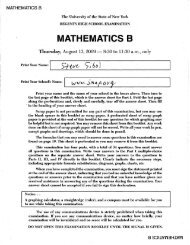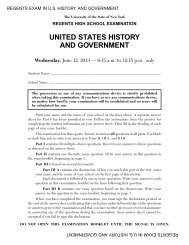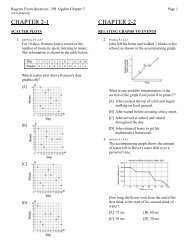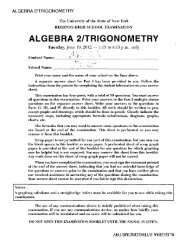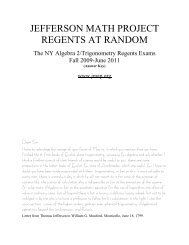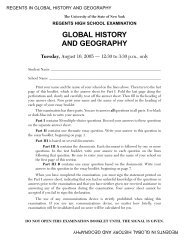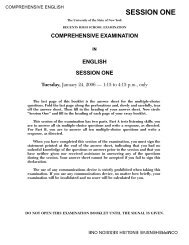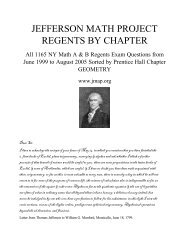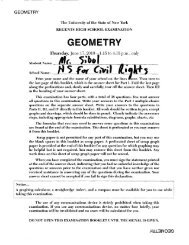IA - JMap
IA - JMap
IA - JMap
You also want an ePaper? Increase the reach of your titles
YUMPU automatically turns print PDFs into web optimized ePapers that Google loves.
INTEGRATED ALGEBRA<br />
The University of the State of New York<br />
REGENTS HIGH SCHOOL EXAMINATION<br />
INTEGRATED ALGEBRA<br />
Thursday, January 28, 2010 — 1:15 to 4:15 p.m., only<br />
Student Name:________________________________________________________<br />
School Name: ______________________________________________________________<br />
Print your name and the name of your school on the lines above. Then turn to<br />
the last page of this booklet, which is the answer sheet for Part I. Fold the last page<br />
along the perforations and, slowly and carefully, tear off the answer sheet. Then<br />
fill in the heading of your answer sheet.<br />
This examination has four parts, with a total of 39 questions. You must answer<br />
all questions in this examination. Write your answers to the Part I multiple-choice<br />
questions on the separate answer sheet. Write your answers to the questions in<br />
Parts II, III, and IV directly in this booklet. All work should be written in pen,<br />
except graphs and drawings, which should be done in pencil. Clearly indicate the<br />
necessary steps, including appropriate formula substitutions, diagrams, graphs,<br />
charts, etc.<br />
The formulas that you may need to answer some questions in this examination<br />
are found at the end of the examination. This sheet is perforated so you may<br />
remove it from this booklet.<br />
Scrap paper is not permitted for any part of this examination, but you may use<br />
the blank spaces in this booklet as scrap paper. A perforated sheet of scrap graph<br />
paper is provided at the end of this booklet for any question for which graphing<br />
may be helpful but is not required. You may remove this sheet from this booklet.<br />
Any work done on this sheet of scrap graph paper will not be scored.<br />
When you have completed the examination, you must sign the statement<br />
printed at the end of the answer sheet, indicating that you had no unlawful<br />
knowledge of the questions or answers prior to the examination and that you have<br />
neither given nor received assistance in answering any of the questions during the<br />
examination. Your answer sheet cannot be accepted if you fail to sign this<br />
declaration.<br />
Notice…<br />
A graphing calculator and a straightedge (ruler) must be available for you to use while taking this<br />
examination.<br />
The use of any communications device is strictly prohibited when taking this<br />
examination. If you use any communications device, no matter how briefly, your<br />
examination will be invalidated and no score will be calculated for you.<br />
DO NOT OPEN THIS EXAMINATION BOOKLET UNTIL THE SIGNAL IS GIVEN.<br />
INTEGRATED ALGEBRA
Part I<br />
Answer all 30 questions in this part. Each correct answer will receive 2 credits. No partial<br />
credit will be allowed. For each question, write on the separate answer sheet the numeral<br />
preceding the word or expression that best completes the statement or answers the question. [60]<br />
1 The box-and-whisker plot below represents the math test scores of<br />
20 students.<br />
Use this space for<br />
computations.<br />
60 70 80 90 100<br />
What percentage of the test scores are less than 72?<br />
(1) 25 (3) 75<br />
(2) 50 (4) 100<br />
2 A bag contains eight green marbles, five white marbles, and two red<br />
marbles. What is the probability of drawing a red marble from the<br />
bag?<br />
(1)<br />
1<br />
15<br />
(3)<br />
(2)<br />
2<br />
15<br />
(4)<br />
2<br />
13<br />
13<br />
15<br />
3 Julia went to the movies and bought one jumbo popcorn and two<br />
chocolate chip cookies for $5.00. Marvin went to the same movie and<br />
bought one jumbo popcorn and four chocolate chip cookies for $6.00.<br />
How much does one chocolate chip cookie cost?<br />
(1) $0.50 (3) $1.00<br />
(2) $0.75 (4) $2.00<br />
Integrated Algebra – January ’10 [2]
4 Given:<br />
Q = {0, 2, 4, 6}<br />
W= {0, 1, 2, 3}<br />
Z = {1, 2, 3, 4}<br />
What is the intersection of sets Q, W, and Z?<br />
(1) {2} (3) {1, 2, 3}<br />
(2) {0, 2} (4) {0, 1, 2, 3, 4, 6}<br />
Use this space for<br />
computations.<br />
5 Roger is having a picnic for 78 guests. He plans to serve each guest<br />
at least one hot dog. If each package, p, contains eight hot dogs,<br />
which inequality could be used to determine how many packages of<br />
hot dogs Roger will need to buy?<br />
(1) p ≥ 78 (3) 8 + p ≥ 78<br />
(2) 8p ≥ 78 (4) 78 − p ≥ 8<br />
6 In a science fiction novel, the main character found a mysterious<br />
rock that decreased in size each day. The table below shows the part<br />
of the rock that remained at noon on successive days.<br />
Day<br />
1<br />
2<br />
3<br />
4<br />
Fractional Part of<br />
the Rock Remaining<br />
1<br />
1<br />
2<br />
1<br />
4<br />
1<br />
8<br />
Which fractional part of the rock will remain at noon on day 7?<br />
(1)<br />
1<br />
1<br />
128<br />
(3)<br />
14<br />
(2)<br />
1<br />
1<br />
64<br />
(4)<br />
12<br />
Integrated Algebra – January ’10 [3] [OVER]
7 In the diagram below, what is the slope of the line passing through<br />
points A and B?<br />
Use this space for<br />
computations.<br />
y<br />
B<br />
A<br />
x<br />
(1) −2 (3)<br />
(2) 2 (4)<br />
− 1 2<br />
1<br />
2<br />
Integrated Algebra – January ’10 [4]
8 Which equation shows a correct trigonometric ratio for angle A in<br />
the right triangle below?<br />
Use this space for<br />
computations.<br />
B<br />
8 cm<br />
17 cm<br />
C 15 cm A<br />
(1) sin A = 15<br />
17<br />
(3)<br />
(2) tan A = 8<br />
17<br />
(4)<br />
cos A = 15<br />
17<br />
tan A = 15 8<br />
9 Debbie solved the linear equation 3(x + 4) − 2 = 16 as follows:<br />
She made an error between lines<br />
(1) 1 and 2 (3) 3 and 4<br />
(2) 2 and 3 (4) 4 and 5<br />
Integrated Algebra – January ’10 [5] [OVER]
10 The value of the expression −|a − b| when a = 7 and b =−3 is<br />
(1) −10 (3) −4<br />
(2) 10 (4) 4<br />
Use this space for<br />
computations.<br />
11 Which expression represents<br />
12x3 − 6x2<br />
+ 2x<br />
in simplest form?<br />
2x<br />
(1) 6x 2 − 3x (3) 6x 2 − 3x + 1<br />
(2) 10x 2 − 4x (4) 10x 2 − 4x + 1<br />
12 Which ordered pair is a solution of the system of equations shown<br />
in the graph below?<br />
y<br />
x<br />
(1) (−3, 1) (3) (0,−1)<br />
(2) (−3, 5) (4) (0,−4)<br />
Integrated Algebra – January ’10 [6]
13 Which equation represents the line that passes through the points<br />
(−3,7) and (3,3)?<br />
Use this space for<br />
computations.<br />
(1) y =<br />
2<br />
x+<br />
1<br />
3<br />
(3)<br />
(2) y =<br />
2<br />
x+<br />
9<br />
3<br />
(4)<br />
y =−<br />
2<br />
x+<br />
5<br />
3<br />
y =−<br />
2<br />
x+<br />
9<br />
3<br />
14 Which data table represents univariate data?<br />
Side Length Area of<br />
of a Square Square<br />
2 4<br />
3 9<br />
4 16<br />
5 25<br />
(1)<br />
Age<br />
Group<br />
Frequency<br />
20–29 9<br />
30–39 7<br />
40–49 10<br />
50–59 4<br />
(3)<br />
Hours<br />
Worked<br />
Pay<br />
20 $160<br />
25 $200<br />
30 $240<br />
35 $280<br />
(2)<br />
Number of<br />
People<br />
Fingers<br />
2 20<br />
3 30<br />
4 40<br />
5 50<br />
(4)<br />
Integrated Algebra – January ’10 [7] [OVER]
15 What is the equation of the axis of symmetry of the parabola shown<br />
in the diagram below?<br />
Use this space for<br />
computations.<br />
20<br />
18<br />
16<br />
14<br />
12<br />
10<br />
8<br />
6<br />
4<br />
2<br />
y<br />
1 2 3 4 5 6 7 8 9 10<br />
x<br />
(1) x =−0.5 (3) x = 4.5<br />
(2) x = 2 (4) x = 13<br />
16 The members of the senior class are planning a dance. They use the<br />
equation r = pn to determine the total receipts. What is n expressed<br />
in terms of r and p?<br />
(1) n = r + p (3)<br />
n =<br />
(2) n = r − p (4) n =<br />
p<br />
r<br />
r<br />
p<br />
Integrated Algebra – January ’10 [8]
17 The graph of the equation y = |x| is shown in the diagram below.<br />
Use this space for<br />
computations.<br />
y<br />
x<br />
Which diagram could represent a graph of the equation y = a|x| when<br />
−1 < a < 0?<br />
y<br />
y<br />
x<br />
x<br />
(1)<br />
y<br />
(3)<br />
y<br />
x<br />
x<br />
(2)<br />
(4)<br />
Integrated Algebra – January ’10 [9] [OVER]
18 Which relation represents a function?<br />
(1) {(0,3), (2,4), (0,6)}<br />
(2) {(−7,5), (−7,1), (−10,3), (−4,3)}<br />
(3) {(2,0), (6,2), (6,−2)}<br />
(4) {(−6,5), (−3,2), (1,2), (6,5)}<br />
Use this space for<br />
computations.<br />
19 Which scatter plot shows the relationship between x and y if<br />
x represents a student score on a test and y represents the number<br />
of incorrect answers a student received on the same test?<br />
y<br />
y<br />
Number of<br />
Incorrect Answers<br />
Number of<br />
Incorrect Answers<br />
Test Scores<br />
x<br />
Test Scores<br />
x<br />
(1)<br />
(3)<br />
y<br />
y<br />
Number of<br />
Incorrect Answers<br />
Number of<br />
Incorrect Answers<br />
Test Scores<br />
x<br />
Test Scores<br />
x<br />
(2)<br />
(4)<br />
Integrated Algebra – January ’10 [10]
20 Which expression is equivalent to 3 3 •3 4 ?<br />
(1) 9 12 (3) 3 12<br />
(2) 9 7 (4) 3 7<br />
Use this space for<br />
computations.<br />
21 Which point is on the line 4y − 2x = 0?<br />
(1) (−2,−1) (3) (−1,−2)<br />
(2) (−2,1) (4) (1,2)<br />
22 If Ann correctly factors an expression that is the difference of two<br />
perfect squares, her factors could be<br />
(1) (2x + y)(x − 2y) (3) (x − 4)(x − 4)<br />
(2) (2x + 3y)(2x − 3y) (4) (2y − 5)(y − 5)<br />
23 Which ordered pair is in the solution set of the following system of<br />
linear inequalities?<br />
y < 2x + 2<br />
y ≥−x − 1<br />
(1) (0,3) (3) (−1,0)<br />
(2) (2,0) (4) (−1,−4)<br />
Integrated Algebra – January ’10 [11] [OVER]
24 The expression 6 50 + 6 2 written in simplest radical form is<br />
Use this space for<br />
computations.<br />
(1) 6 52<br />
(3)<br />
(2) 12 52<br />
(4)<br />
17 2<br />
36 2<br />
25 What is the sum of<br />
3x 2 x<br />
2<br />
x − 2 and x − 2<br />
?<br />
(1)<br />
3x4<br />
( x − 2)<br />
2<br />
(3)<br />
(2)<br />
3x x − 2<br />
(4)<br />
4x2<br />
( x − 2)<br />
4x 2<br />
x − 2<br />
2<br />
26 Which equation represents a line parallel to the graph of<br />
2x − 4y = 16?<br />
(1) y =<br />
1<br />
x − 5<br />
(3) y =−2x + 6<br />
2<br />
(2) y =−<br />
1<br />
x+<br />
4<br />
(4) y = 2x + 8<br />
2<br />
27 An example of an algebraic expression is<br />
(1)<br />
2x<br />
+ 3<br />
=<br />
13<br />
(3) 4x − 1 = 4<br />
7 x<br />
(2) (2x + 1)(x − 7) (4) x = 2<br />
Integrated Algebra – January ’10 [12]
Use this space for<br />
28 What is the solution set of<br />
x + 2 = − 3 ?<br />
computations.<br />
x − 2 x<br />
(1) {−2, 3} (3) {−1, 6}<br />
(2) {−3, −2} (4) {−6, 1}<br />
29 How many square inches of wrapping paper are needed to entirely<br />
cover a box that is 2 inches by 3 inches by 4 inches?<br />
(1) 18 (3) 26<br />
(2) 24 (4) 52<br />
30 Which situation describes a correlation that is not a causal<br />
relationship?<br />
(1) the length of the edge of a cube and the volume of the cube<br />
(2) the distance traveled and the time spent driving<br />
(3) the age of a child and the number of siblings the child has<br />
(4) the number of classes taught in a school and the number of<br />
teachers employed<br />
Integrated Algebra – January ’10 [13] [OVER]
Part II<br />
Answer all 3 questions in this part. Each correct answer will receive 2 credits. Clearly indicate the<br />
necessary steps, including appropriate formula substitutions, diagrams, graphs, charts, etc. For all<br />
questions in this part, a correct numerical answer with no work shown will receive only 1 credit. [6]<br />
31 Angela wants to purchase carpeting for her living room. The dimensions of her living room are<br />
12 feet by 12 feet. If carpeting is sold by the square yard, determine how many square yards of<br />
carpeting she must purchase.<br />
3 feet = 1 yard<br />
9 square feet = 1 square yard<br />
Integrated Algebra – January ’10 [14]
32 In right triangle ABC, AB = 20, AC = 12, BC = 16, and m∠C = 90.<br />
Find, to the nearest degree, the measure of ∠A.<br />
Integrated Algebra – January ’10 [15] [OVER]
33 Jon is buying tickets for himself for two concerts. For the jazz concert, 4 tickets are available in the<br />
front row, and 32 tickets are available in the other rows. For the orchestra concert, 3 tickets are<br />
available in the front row, and 23 tickets are available in the other rows. Jon is randomly assigned<br />
one ticket for each concert.<br />
Determine the concert for which he is more likely to get a front-row ticket. Justify your answer.<br />
Integrated Algebra – January ’10 [16]
Part III<br />
Answer all 3 questions in this part. Each correct answer will receive 3 credits. Clearly indicate the<br />
necessary steps, including appropriate formula substitutions, diagrams, graphs, charts, etc. For all<br />
questions in this part, a correct numerical answer with no work shown will receive only 1 credit. [9]<br />
34 Find the roots of the equation x 2 − x = 6 algebraically.<br />
Integrated Algebra – January ’10 [17] [OVER]
35 Ms. Mosher recorded the math test scores of six students in the table below.<br />
Student<br />
Student<br />
Score<br />
Andrew 72<br />
John 80<br />
George 85<br />
Amber 93<br />
Betty 78<br />
Roberto 80<br />
Determine the mean of the student scores, to the nearest tenth.<br />
Determine the median of the student scores.<br />
Describe the effect on the mean and the median if Ms. Mosher adds 5 bonus points to each of the<br />
six students’ scores.<br />
Integrated Algebra – January ’10 [18]
36 Using his ruler, Howell measured the sides of a rectangular prism to be 5 cm by 8 cm by 4 cm. The<br />
actual measurements are 5.3 cm by 8.2 cm by 4.1 cm. Find Howell’s relative error in calculating the<br />
volume of the prism, to the nearest thousandth.<br />
Integrated Algebra – January ’10 [19] [OVER]
Part IV<br />
Answer all 3 questions in this part. Each correct answer will receive 4 credits. Clearly indicate<br />
the necessary steps, including appropriate formula substitutions, diagrams, graphs, charts, etc.<br />
For all questions in this part, a correct numerical answer with no work shown will receive only<br />
1 credit. [12]<br />
37 A password consists of three digits, 0 through 9, followed by three letters from an alphabet having<br />
26 letters.<br />
If repetition of digits is allowed, but repetition of letters is not allowed, determine the number of<br />
different passwords that can be made.<br />
If repetition is not allowed for digits or letters, determine how many fewer different passwords can<br />
be made.<br />
Integrated Algebra – January ’10 [20]
38 Graph the solution set for the inequality 4x − 3y > 9 on the set of axes below.<br />
Determine if the point (1,−3) is in the solution set. Justify your answer.<br />
y<br />
x<br />
Integrated Algebra – January ’10 [21] [OVER]
39 Find three consecutive positive even integers such that the product of the second and third<br />
integers is twenty more than ten times the first integer. [Only an algebraic solution can receive full<br />
credit.]<br />
Integrated Algebra – January ’10 [22]
Reference Sheet<br />
Tear Here Tear Here<br />
Trigonometric Ratios<br />
sin A =<br />
cos A =<br />
tan A =<br />
opposite<br />
hypotenuse<br />
adjacent<br />
hypotenuse<br />
opposite<br />
adjacent<br />
1<br />
Area trapezoid A = –h(b<br />
2 1 + b 2 )<br />
Volume cylinder V = πr 2 h<br />
Surface Area<br />
Coordinate Geometry<br />
rectangular prism<br />
cylinder<br />
Δy<br />
m =<br />
Δx<br />
=<br />
SA = 2πr 2 + 2πrh<br />
y 2 – y 1<br />
x 2 – x 1<br />
SA = 2lw + 2hw + 2lh<br />
Integrated Algebra – January ’10 [23]
Tear Here Tear Here<br />
Scrap Graph Paper — This sheet will not be scored.
Scrap Graph Paper — This sheet will not be scored.<br />
Tear Here<br />
Tear Here
The University of the State of New York<br />
REGENTS HIGH SCHOOL EXAMINATION<br />
INTEGRATED ALGEBRA<br />
Tear Here Tear Here<br />
Thursday, January 28, 2010 — 1:15 to 4:15 p.m., only<br />
ANSWER SHEET<br />
Student . . . . . . . . . . . . . . . . . . . . . . . . . . . . . . . . . . . . . . . . . . . . . . Sex: ■ Male ■ Female Grade . . . . . . . . . .<br />
Teacher . . . . . . . . . . . . . . . . . . . . . . . . . . . . . . . . . . . . . . . . . . . . . . School . . . . . . . . . . . . . . . . . . . . . . . . . . . . . . . . . . . .<br />
Your answers to Part I should be recorded on this answer sheet.<br />
1 . . . . . . . . . . . . . . . . . . . . 9 . . . . . . . . . . . . . . . . . . . .<br />
2 . . . . . . . . . . . . . . . . . . . . 10 . . . . . . . . . . . . . . . . . . . .<br />
3 . . . . . . . . . . . . . . . . . . . . 11 . . . . . . . . . . . . . . . . . . . .<br />
4 . . . . . . . . . . . . . . . . . . . . 12 . . . . . . . . . . . . . . . . . . . .<br />
5 . . . . . . . . . . . . . . . . . . . . 13 . . . . . . . . . . . . . . . . . . . .<br />
6 . . . . . . . . . . . . . . . . . . . . 14 . . . . . . . . . . . . . . . . . . . .<br />
7 . . . . . . . . . . . . . . . . . . . . 15 . . . . . . . . . . . . . . . . . . . .<br />
8 . . . . . . . . . . . . . . . . . . . . 16 . . . . . . . . . . . . . . . . . . . .<br />
Part I<br />
Answer all 30 questions in this part.<br />
17 . . . . . . . . . . . . . . . . . . . . 25 . . . . . . . . . . . . . . . . . . . .<br />
18 . . . . . . . . . . . . . . . . . . . . 26 . . . . . . . . . . . . . . . . . . . .<br />
19 . . . . . . . . . . . . . . . . . . . . 27 . . . . . . . . . . . . . . . . . . . .<br />
20 . . . . . . . . . . . . . . . . . . . . 28 . . . . . . . . . . . . . . . . . . . .<br />
21 . . . . . . . . . . . . . . . . . . . . 29 . . . . . . . . . . . . . . . . . . . .<br />
22 . . . . . . . . . . . . . . . . . . . . 30 . . . . . . . . . . . . . . . . . . . .<br />
23 . . . . . . . . . . . . . . . . . . . .<br />
24 . . . . . . . . . . . . . . . . . . . .<br />
Your answers for Parts II, III, and IV should be written in the test booklet.<br />
The declaration below must be signed when you have completed the examination.<br />
I do hereby affirm, at the close of this examination, that I had no unlawful knowledge of the questions or answers prior to<br />
the examination and that I have neither given nor received assistance in answering any of the questions during the examination.<br />
Signature<br />
Integrated Algebra – January ’10 [27]
INTEGRATED ALGEBRA<br />
INTEGRATED ALGEBRA<br />
Rater’s/Scorer’s Name<br />
(minimum of three)<br />
Maximum Credits Rater’s/Scorer’s<br />
Question Credit Earned Initials<br />
Part I 1–30 60<br />
Tear Here<br />
Part II 31 2<br />
32 2<br />
33 2<br />
Part III 34 3<br />
35 3<br />
36 3<br />
Part IV 37 4<br />
38 4<br />
39 4<br />
Maximum 87<br />
Total<br />
Total Raw<br />
Score<br />
Checked by<br />
Scale Score<br />
(from conversion chart)<br />
Tear Here<br />
Integrated Algebra – January ’10 [28]<br />
INTEGRATED ALGEBRA
FOR TEACHERS ONLY<br />
The University of the State of New York<br />
REGENTS HIGH SCHOOL EXAMINATION<br />
INTEGRATED ALGEBRA<br />
Thursday, January 28, 2010 — 1:15 to 4:15 p.m., only<br />
SCORING KEY AND RATING GUIDE<br />
Mechanics of Rating<br />
The following procedures are to be followed for scoring student answer papers for the<br />
Regents Examination in Integrated Algebra. More detailed information about scoring is<br />
provided in the publication Information Booklet for Scoring the Regents Examinations in<br />
Integrated Algebra and Geometry.<br />
Use only red ink or red pencil in rating Regents papers. Do not attempt to correct the<br />
student’s work by making insertions or changes of any kind. Use check marks to indicate<br />
student errors.<br />
Unless otherwise specified, mathematically correct variations in the answers will be<br />
allowed. Units need not be given when the wording of the questions allows such omissions.<br />
Each student’s answer paper is to be scored by a minimum of three mathematics teachers.<br />
On the back of the student’s detachable answer sheet, raters must enter their initials in the<br />
boxes next to the questions they have scored and also write their name in the box under the<br />
heading “Rater’s/Scorer’s Name.”<br />
Raters should record the student’s scores for all questions and the total raw score on the<br />
student’s detachable answer sheet. Then the student’s total raw score should be converted to a<br />
scale score by using the conversion chart that will be posted on the Department’s web site<br />
http://www.emsc.nysed.gov/osa/ on Thursday, January 28, 2010. The student’s scale score<br />
should be entered in the box provided on the student’s detachable answer sheet. The scale<br />
score is the student’s final examination score.
INTEGRATED ALGEBRA – continued<br />
Part I<br />
Allow a total of 60 credits, 2 credits for each of the following. Allow credit if the student<br />
has written the correct answer instead of the numeral 1, 2, 3, or 4.<br />
(1) 1 (9) 2 (17) 3 (25) 4<br />
(2) 2 (10) 1 (18) 4 (26) 1<br />
(3) 1 (11) 3 (19) 2 (27) 2<br />
(4) 1 (12) 2 (20) 4 (28) 4<br />
(5) 2 (13) 3 (21) 1 (29) 4<br />
(6) 2 (14) 3 (22) 2 (30) 3<br />
(7) 4 (15) 2 (23) 2<br />
(8) 3 (16) 4 (24) 4<br />
[2]
INTEGRATED ALGEBRA – continued<br />
Updated information regarding the rating of this examination may be posted on the New York State<br />
Education Department’s web site during the rating period. Check this web site http://www.emsc.nysed.gov/osa/<br />
and select the link “Examination Scoring Information” for any recently posted information regarding this<br />
examination. This site should be checked before the rating process for this examination begins and several times<br />
throughout the Regents examination period.<br />
General Rules for Applying Mathematics Rubrics<br />
I. General Principles for Rating<br />
The rubrics for the constructed-response questions on the Regents Examinations in Integrated Algebra are designed to<br />
provide a systematic, consistent method for awarding credit. The rubrics are not to be considered all-inclusive; it is<br />
impossible to anticipate all the different methods that students might use to solve a given problem. Each response must be<br />
rated carefully using the teacher’s professional judgment and knowledge of mathematics; all calculations must be checked.<br />
The specific rubrics for each question must be applied consistently to all responses. In cases that are not specifically<br />
addressed in the rubrics, raters must follow the general rating guidelines in the publication Information Booklet for Scoring<br />
the Regents Examinations in Integrated Algebra and Geometry, use their own professional judgment, confer with other<br />
mathematics teachers, and/or contact the State Education Department for guidance. During each Regents examination<br />
administration period, rating questions may be referred directly to the Education Department. The contact numbers are sent<br />
to all schools before each administration period.<br />
II. Full-Credit Responses<br />
A full-credit response provides a complete and correct answer to all parts of the question. Sufficient work is shown to enable<br />
the rater to determine how the student arrived at the correct answer.<br />
When the rubric for the full-credit response includes one or more examples of an acceptable method for solving the question<br />
(usually introduced by the phrase “such as”), it does not mean that there are no additional acceptable methods of arriving at the<br />
correct answer. Unless otherwise specified, mathematically correct alternative solutions should be awarded credit. The only<br />
exceptions are those questions that specify the type of solution that must be used; e.g., an algebraic solution or a graphic<br />
solution. A correct solution using a method other than the one specified is awarded half the credit of a correct solution using<br />
the specified method.<br />
III. Appropriate Work<br />
Full-Credit Responses: The directions in the examination booklet for all the constructed-response questions state: “Clearly<br />
indicate the necessary steps, including appropriate formula substitutions, diagrams, charts, etc.” The student has the<br />
responsibility of providing the correct answer and showing how that answer was obtained. The student must “construct” the<br />
response; the teacher should not have to search through a group of seemingly random calculations scribbled on the student<br />
paper to ascertain what method the student may have used.<br />
Responses With Errors: Rubrics that state “Appropriate work is shown, but …” are intended to be used with solutions that<br />
show an essentially complete response to the question but contain certain types of errors, whether computational, rounding,<br />
graphing, or conceptual. If the response is incomplete; i.e., an equation is written but not solved or an equation is solved but<br />
not all of the parts of the question are answered, appropriate work has not been shown. Other rubrics address incomplete<br />
responses.<br />
IV. Multiple Errors<br />
Computational Errors, Graphing Errors, and Rounding Errors: Each of these types of errors results in a 1-credit deduction.<br />
Any combination of two of these types of errors results in a 2-credit deduction. No more than 2 credits should be deducted for<br />
such mechanical errors in any response. The teacher must carefully review the student’s work to determine what errors were<br />
made and what type of errors they were.<br />
Conceptual Errors: A conceptual error involves a more serious lack of knowledge or procedure. Examples of conceptual<br />
errors include using the incorrect formula for the area of a figure, choosing the incorrect trigonometric function, or<br />
multiplying the exponents instead of adding them when multiplying terms with exponents. A response with one conceptual<br />
error can receive no more than half credit.<br />
If a response shows repeated occurrences of the same conceptual error, the student should not be penalized twice. If the same<br />
conceptual error is repeated in responses to other questions, credit should be deducted in each response.<br />
If a response shows two (or more) different major conceptual errors, it should be considered completely incorrect and<br />
receive no credit.<br />
If a response shows one conceptual error and one computational, graphing, or rounding error, the teacher must award credit<br />
that takes into account both errors; i.e., awarding half credit for the conceptual error and deducting 1 credit for each<br />
mechanical error (maximum of two deductions for mechanical errors).<br />
[3] [OVER]
INTEGRATED ALGEBRA – continued<br />
Part II<br />
For each question, use the specific criteria to award a maximum of two credits. Unless<br />
otherwise specified, mathematically correct alternative solutions should be awarded<br />
appropriate credit.<br />
(31) [2] 16, and appropriate work is shown.<br />
[1] Appropriate work is shown, but one computational error is made.<br />
[1] Appropriate work is shown, but one conceptual error is made.<br />
[1] 16, but no work is shown.<br />
or<br />
or<br />
[0] A zero response is completely incorrect, irrelevant, or incoherent or is a<br />
correct response that was obtained by an obviously incorrect procedure.<br />
(32) [2] 53, and appropriate work is shown.<br />
[1] Appropriate work is shown, but one computational or rounding error is<br />
made.<br />
or<br />
[1] Appropriate work is shown, but one conceptual error is made, such as<br />
using an incorrect trigonometric function.<br />
or<br />
[1] A correct trigonometric equation is written, but no further correct work is<br />
shown.<br />
[1] 53, but no work is shown.<br />
or<br />
[0] A zero response is completely incorrect, irrelevant, or incoherent or is a<br />
correct response that was obtained by an obviously incorrect procedure.<br />
[4]
INTEGRATED ALGEBRA – continued<br />
(33) [2] Orchestra, and appropriate work is shown as justification.<br />
[1] Appropriate work is shown, but one computational error is made.<br />
or<br />
[1] Appropriate work is shown, but one conceptual error is made, such as not<br />
dividing by the total number of tickets available.<br />
[1] Appropriate work is shown, but orchestra is not stated.<br />
or<br />
[0] Orchestra, but no work is shown.<br />
or<br />
[0] A zero response is completely incorrect, irrelevant, or incoherent or is a<br />
correct response that was obtained by an obviously incorrect procedure.<br />
[5] [OVER]
INTEGRATED ALGEBRA – continued<br />
Part III<br />
For each question, use the specific criteria to award a maximum of three credits. Unless<br />
otherwise specified, mathematically correct alternative solutions should be awarded<br />
appropriate credit.<br />
(34) [3] –2 and 3, and appropriate algebraic work is shown.<br />
[2] Appropriate work is shown, but one computational or factoring error is<br />
made, but two appropriate solutions are stated.<br />
or<br />
[2] Appropriate work is shown to find (x – 3)(x + 2) = 0, but no further correct<br />
work is shown.<br />
[1] Appropriate work is shown, but two or more computational or factoring<br />
errors are made, but two appropriate solutions are stated.<br />
[1] Appropriate work is shown, but one conceptual error is made.<br />
or<br />
or<br />
[1] An appropriate quadratic equation in standard form (set equal to zero) is<br />
written, but no further correct work is shown.<br />
[1] –2 and 3, but a method other than algebraic is used.<br />
or<br />
or<br />
[1] –2 and 3, but no work is shown.<br />
[0] –2 or 3, but no work is shown.<br />
or<br />
[0] A zero response is completely incorrect, irrelevant, or incoherent or is a<br />
correct response that was obtained by an obviously incorrect procedure.<br />
[6]
INTEGRATED ALGEBRA – continued<br />
(35) [3] Mean = 81.3, median = 80, and appropriate work is shown, and an<br />
appropriate description is given, such as that both the mean and median<br />
will increase or that the mean becomes 86.3 and the median becomes 85.<br />
[2] Appropriate work is shown, but one computational or rounding error is<br />
made, but an appropriate description is given.<br />
or<br />
[2] Mean = 81.3, median = 80, and appropriate work is shown, but the<br />
description is missing or is incorrect.<br />
or<br />
[2] Mean = 81.3 and median = 80, but no work is shown, but an appropriate<br />
description is given.<br />
[1] Appropriate work is shown, but two or more computational or rounding<br />
errors are made, but an appropriate description is given.<br />
or<br />
[1] Appropriate work is shown, but one conceptual error is made, but an<br />
appropriate description is given.<br />
or<br />
[1] Mean = 81.3 and median = 80, but no work is shown, and no description is<br />
given.<br />
[0] Mean = 81.3 or median = 80, but no work is shown, and no description is<br />
given.<br />
or<br />
[0] A zero response is completely incorrect, irrelevant, or incoherent or is a<br />
correct response that was obtained by an obviously incorrect procedure.<br />
[7] [OVER]
INTEGRATED ALGEBRA – continued<br />
(36) [3] 0.102, and appropriate work is shown.<br />
[2] Appropriate work is shown, but one computational or rounding error is<br />
made.<br />
or<br />
178.186 160<br />
[2] or an equivalent expression, but the relative error is not<br />
178.186<br />
found or is found incorrectly.<br />
[1] Appropriate work is shown, but two or more computational or rounding<br />
errors are made.<br />
or<br />
[1] Appropriate work is shown, but one conceptual error is made, such as<br />
dividing by 160.<br />
or<br />
[1] Appropriate work is shown to find 160 and 178.186, but no further correct<br />
work is shown.<br />
[1] 0.102, but no work is shown.<br />
or<br />
[0] A zero response is completely incorrect, irrelevant, or incoherent or is a<br />
correct response that was obtained by an obviously incorrect procedure.<br />
[8]
INTEGRATED ALGEBRA – continued<br />
Part IV<br />
For each question, use the specific criteria to award a maximum of four credits. Unless<br />
otherwise specified, mathematically correct alternative solutions should be awarded<br />
appropriate credit.<br />
(37) [4] 15,600,000 and 4,368,000, and appropriate work is shown.<br />
[3] Appropriate work is shown, but one computational error is made.<br />
or<br />
[3] Appropriate work is shown to find 15,600,000 and 11,232,000, but the<br />
values are not subtracted.<br />
[2] Appropriate work is shown, but two or more computational errors are<br />
made.<br />
[2] Appropriate work is shown, but one conceptual error is made.<br />
or<br />
[1] Appropriate work is shown, but one conceptual error and one<br />
computational error are made.<br />
or<br />
[1] Appropriate work is shown to find 15,600,000 or 11,232,000, but no<br />
further correct work is shown.<br />
or<br />
[1] 10•10•10•26•25•24 and 10•9•8•26•25•24, but no further correct work is<br />
shown.<br />
[1] 15,600,000 and 4,368,000, but no work is shown.<br />
[0] 15,600,000 or 4,368,000, but no work is shown.<br />
or<br />
or<br />
[0] A zero response is completely incorrect, irrelevant, or incoherent or is a<br />
correct response that was obtained by an obviously incorrect procedure.<br />
[9] [OVER]
INTEGRATED ALGEBRA – continued<br />
(38) [4] The inequality is graphed correctly, and “yes” and an appropriate justification<br />
is given, such as plotting the point or checking algebraically.<br />
[3] Appropriate work is shown, but one graphing error is made, such as drawing<br />
a solid line or shading incorrectly, but an appropriate answer and justification<br />
are given.<br />
[2] Appropriate work is shown, but two or more graphing errors are made, but<br />
an appropriate answer and justification are given.<br />
or<br />
[2] Appropriate work is shown, but one conceptual error is made, but an<br />
appropriate answer and justification are given.<br />
[2] The inequality is graphed correctly, but no further correct work is shown.<br />
or<br />
[1] Appropriate work is shown, but one conceptual error and one graphing<br />
error are made, but an appropriate answer and justification are given.<br />
or<br />
[1] The line 4x – 3y = 9 is graphed correctly, but no further correct work is<br />
shown.<br />
or<br />
[1] Algebraic work is shown determining that (1,–3) is in the solution set, but<br />
no graph is shown.<br />
[0] “Yes,” but no work is shown.<br />
or<br />
[0] A zero response is completely incorrect, irrelevant, or incoherent or is a<br />
correct response that was obtained by an obviously incorrect procedure.<br />
[10]
INTEGRATED ALGEBRA – continued<br />
(39) [4] 6, 8, and 10, and appropriate algebraic work is shown.<br />
[3] Appropriate work is shown, but one computational or factoring error is<br />
made.<br />
or<br />
[3] Appropriate work is shown, but only one correct positive integer is found.<br />
[2] Appropriate work is shown, but two or more computational or factoring<br />
errors are made.<br />
or<br />
[2] Appropriate work is shown, but one conceptual error is made, such as<br />
finding consecutive integers.<br />
or<br />
[2] A correct quadratic equation in standard form (set equal to zero) is written,<br />
but no further correct work is shown.<br />
or<br />
[2] 6, 8, and 10, but a method other than algebraic is used.<br />
[1] Appropriate work is shown, but one conceptual error and one<br />
computational or factoring error are made.<br />
or<br />
[1] An appropriate equation is written, but no further correct work is shown.<br />
or<br />
[1] 6, 8, and 10, but no work is shown.<br />
[0] 6 or 8 or 10, but no work is shown.<br />
or<br />
[0] A zero response is completely incorrect, irrelevant, or incoherent or is a<br />
correct response that was obtained by an obviously incorrect procedure.<br />
[11] [OVER]
INTEGRATED ALGEBRA – concluded<br />
Map to Core Curriculum<br />
Content Strand<br />
Item Numbers<br />
Number Sense and Operations 10, 24, 37<br />
Algebra<br />
3, 4, 5, 6, 7, 8, 9, 11, 13, 16, 20, 21,<br />
22, 23, 25, 26, 27, 28, 32, 34, 39<br />
Geometry 12, 15, 17, 18, 29, 38<br />
Measurement 31, 36<br />
Statistics and Probability 1, 2, 14, 19, 30, 33, 35<br />
Regents Examination in Integrated Algebra<br />
January 2010<br />
Chart for Converting Total Test Raw Scores to<br />
Final Examination Scores (Scale Scores)<br />
The Chart for Determining the Final Examination Score for the January 2010<br />
Regents Examination in Integrated Algebra will be posted on the Department’s<br />
web site http://www.emsc.nysed.gov/osa/ on Thursday, January 28, 2010.<br />
Conversion charts provided for previous administrations of the Integrated<br />
Algebra examination must NOT be used to determine students’ final scores for<br />
this administration.<br />
Submitting Teacher Evaluations of the Test to the Department<br />
Suggestions and feedback from teachers provide an important contribution to the test<br />
development process. The Department provides an online evaluation form for State<br />
assessments. It contains spaces for teachers to respond to several specific questions and to make<br />
suggestions. Instructions for completing the evaluation form are as follows:<br />
1. Go to www.emsc.nysed.gov/osa/exameval.<br />
2. Select the test title.<br />
3. Complete the required demographic fields.<br />
4. Complete each evaluation question and provide comments in the space provided.<br />
5. Click the SUBMIT button at the bottom of the page to submit the completed form.<br />
[12]
Regents Examination in Integrated Algebra<br />
January 2010<br />
Chart for Converting Total Test Raw Scores to<br />
Final Examination Scores (Scale Scores)<br />
Raw<br />
Score<br />
Scale<br />
Score<br />
Raw<br />
Score<br />
Scale<br />
Score<br />
Raw<br />
Score<br />
Scale<br />
Score<br />
Raw<br />
Score<br />
Scale<br />
Score<br />
87 100 65 85 43 76 21 51<br />
86 99 64 84 42 75 20 49<br />
85 98 63 84 41 75 19 48<br />
84 96 62 84 40 74 18 46<br />
83 95 61 84 39 73 17 44<br />
82 94 60 83 38 73 16 42<br />
81 94 59 83 37 72 15 39<br />
80 93 58 83 36 71 14 37<br />
79 92 57 82 35 70 13 35<br />
78 91 56 82 34 69 12 33<br />
77 91 55 82 33 68 11 30<br />
76 90 54 81 32 67 10 28<br />
75 89 53 81 31 66 9 25<br />
74 89 52 81 30 65 8 23<br />
73 88 51 80 29 63 7 20<br />
72 88 50 80 28 62 6 17<br />
71 87 49 79 27 61 5 15<br />
70 87 48 79 26 59 4 12<br />
69 86 47 78 25 58 3 9<br />
68 86 46 78 24 56 2 6<br />
67 86 45 77 23 55 1 3<br />
66 86 44 77 22 53 0 0<br />
To determine the student’s final examination score, find the student’s total test raw score in<br />
the column labeled “Raw Score” and then locate the scale score that corresponds to that raw<br />
score. The scale score is the student’s final examination score. Enter this score in the space<br />
labeled “Scale Score” on the student’s answer sheet.<br />
All student answer papers that receive a scale score of 60 through 64 must be scored a<br />
second time to ensure the accuracy of the score. For the second scoring, a different committee<br />
of teachers may score the student’s paper or the original committee may score the paper,<br />
except that no teacher may score the same open-ended questions that he/she scored in the<br />
first rating of the paper.<br />
Because scale scores corresponding to raw scores in the conversion chart change from<br />
one examination to another, it is crucial that for each administration, the conversion chart<br />
provided for that administration be used to determine the student’s final score. The chart<br />
above is usable only for this administration of the Regents Examination in Integrated Algebra.


